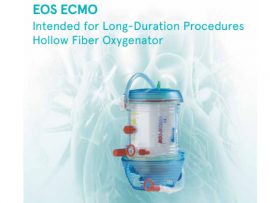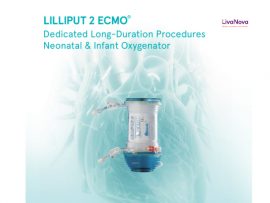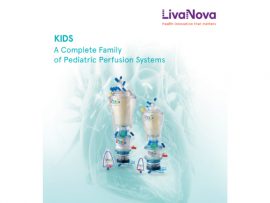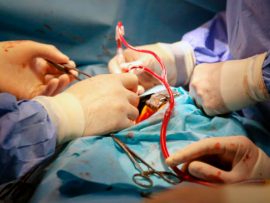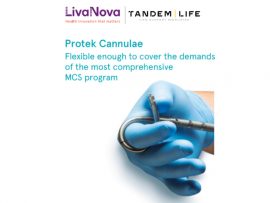Abstract Introduction Transfusion may increase the risk of organ failure through immunomodulatory effects. The primary objective of this study was to assess for patient or transfusion-related factors that are independently..
Lee masAbstract Veno‐venous extracorporeal membrane oxygenation (VV-ECMO) in severe acute respiratory distress syndrome (ARDS) can be lifesaving. In these cases, the complex brain-lung crosstalk might lead to a form of acute..
Lee masAbstract Background Cardiac surgery–associated (AKI) is associated with increased postoperative morbidity and mortality. Evidence suggests an association between perioperative administration and decreased incidence of postoperative AKI in cardiac surgery patients; however, an effect..
Lee masAbstract Weaning and liberation from VA ECMO in cardiogenic shock patients comprises a complex process requiring a continuous trade off between multiple clinical parameters. In the absence of dedicated international..
Lee masAbstract Limb ischaemia is a clinically relevant complication of venoarterial extracorporeal membrane oxygenation (VA ECMO) with femoral artery cannulation. No selective distal perfusion or other advanced techniques were used in..
Lee masAbstract Background Healthcare systems are operating under substantial pressures, and often simply cannot provide the standard of care they aspire to within the available resources. Organisations, managers, and individual clinicians..
Lee masAbstract Introduction Evidence supports the role of oxygen delivery (DO2) in ameliorating acute kidney injury (AKI). While instrumentation for continuous DO2 measurement exists, a simplified method has been reported for targeting..
Lee masAbstract Artificial intelligence (AI) is a transformative technology with many benefits, but also risks when applied to healthcare and cardiac surgery in particular. Surgeons must be aware of AI and..
Lee masAbstract Introduction By using a novel survey our study aimed to assess the challenges ECMO and Critical Care (CC) teams face when initiating and managing patient's ECMO support. Methods A..
Lee masAbstract We read with great interest the article by Zhang and colleagues : a single-center experience showing that although 48.8% of all extracorporeal membrane oxygenation (ECMO) patients are successfully decannulated..
Lee masAbstract Introduction: Intraoperative ultrafiltration (UF) is a procedure used during cardiopulmonary bypass (CPB) to reduce haemodilution and prevent excessive blood transfusion. However, the effect of UF volume on acute kidney injury..
Lee masAbstract OBJECTIVE: To examine characteristics associated with formal ethics consultation (EC) referral in pediatric extracorporeal membrane oxygenation (ECMO) cases, and document ethical issues presented. DESIGN: Retrospective cohort study using mixed..
Lee masAbstract Background During cardiopulmonary bypass (CPB), maintaining adequate oxygen consumption (VO2i) can only be achieved indirectly either by modifying oxygen delivery (DO2i) through its component parts or by modulating metabolic demand..
Lee masAbstract BACKGROUND: Preoperative anemia is associated with adverse outcomes in cardiac surgery, yet it remains unclear what proportion of this association is mediated through red blood cell (RBC) transfusions. METHODS: ..
Lee masAbstract Background The relationship between hyperlactatemia and prognosis after cardiopulmonary bypass (CPB) is controversial, and some studies ignore the presence of lactic acidosis in patients with severe hyperlactacemia. This study..
Lee masAbstract Aims The aim of this trial was to compare the clinical effects of intraoperative haemoadsorption versus standard care in patients undergoing orthotopic heart transplantation (OHT). Methods and results In..
Lee masAbstract Extracorporeal Cardiopulmonary Resuscitation (ECPR) is an emerging approach to cardiac arrest. We present two contrasting cases from a high-volume extracorporeal membrane oxygenation (ECMO) center (defined as greater than 30..
Lee masAbstract BACKGROUND: Acute kidney injury (AKI) is a common complication after cardiac surgery and is associated with increased morbidity and mortality. However, no specific treatment options are available, emphasizing the..
Lee masAbstract Acute kidney injury (AKI) after cardiac surgery is a common complication that can lead to death. We previously reported that the creatinine reduction ratio (CRR) serves as a useful..
Lee masAbstract Background Bleeding and thrombotic complications compromise outcomes in patients undergoing percutaneous mechanical circulatory support (pMCS) with veno-arterial extracorporeal membrane oxygenation (V-A ECMO) and/or microaxial flow pumps like the Impella™...
Lee masAbstract Background Children undergoing cardiac surgery are at risk for acute kidney injury (AKI) and cardiac dysfunction. Opportunity exists in protecting end organ function with remote ischemic preconditioning. We hypothesize..
Lee masAbstract Background Use of venovenous extracorporeal membrane oxygenation (ECMO) is increasing, but candidacy selection processes are variable and subject to bias. Research Question What are the reasons behind venovenous ECMO..
Lee masAbstract Background: Acute kidney injury (AKI) is a common and serious complication after the repair of Type A acute aortic dissection (TA-AAD). However, previous models have failed to account for the..
Lee masAbstract Background: Early detection of acute kidney injury (AKI) is crucial for timely intervention and improved patient outcomes after cardiac surgery. This study aimed to evaluate the potential of urinary..
Lee masAbstract Angiotensin II (ANGII) is a vasoconstrictive eighth amino acid peptide, which increases blood pressure within a complex regulatory and counterregulatory system (Fig. ). ANGII is the key molecule in the..
Lee masAbstract Background As patients with acute kidney injury (AKI) progress to a higher stage, the risk for poor outcomes dramatically rises. Early identification of patients at high risk for AKI..
Lee masAbstract Background Modifiable and non-modifiable factors contribute to development and progression of acute kidney injury (AKI) during cardiac surgery. We hypothesized that, the difference between preoperative mean arterial pressure (MAP)..
Lee masAbstract Background: Coronary artery disease is a condition characterized by atherosclerosis and inflammation in the vessel wall. In patient undergoing surgery, a systemic inflammatory-like condition occurs in the postoperative period..
Lee masAbstract Purpose: The outcomes of immunocompromised patients with cardiogenic shock treated with venoarterial extra‑corporeal membrane oxygenation (VA‑ECMO) are seldom documented, making ECMO candidacy decisions challeng‑ing. This study aims (1) to..
Lee masAbstract Background Patients scheduled for elective surgery typically suffer from preoperative anxiety related to the unknown environment and unclear expectations. We hypothesized that a virtual or in-person introductory visit to..
Lee mas







